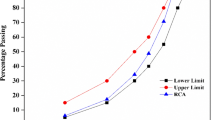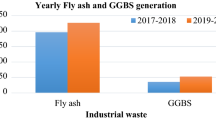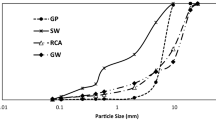Abstract
A large quantity of the rural roads in the world has been connected with all traditional concrete roads and has a low volume of traffic. The common problem for such kinds of roads is sustainability and durability. Geopolymer concrete (GC) roads offer an alternate to the traditional cement-based concrete roads. An acceleratory pavement track (APT) with six segments has been constructed to evaluate the practical approaches of fly ash-ground granulated blast furnace slag (GGBFS)-based GC in the sustainable development of rural road network. This paper presents the non-destructive testing (NDT) on APT to check the quality of GC. Moreover, the mechanical, microstructural, and durability characteristics have been analyzed on samples prepared at the time of APT construction. In this paper, efforts have been made to elaborate on the corrosion resistance and chloride resistance of GC after 28 days of ambient curing. The highest compressive strength of 56.63 MPa was obtained for mix with 70% FA, 30% GGBFS, and 0.4 S/B ratio sample after 28 days of ambient curing, and this value is strengthened by rebound hammer result, i.e., 55.7 MPa, conducted on APT without load revolution. The increase in the number of load repetitions on APT found a decrease in rebound and ultrasonic pulse velocity values. Geopolymer concrete mix with 30% GGBFS attained superior NDT behavior upon load repetitions on APT, and similar improved characteristics were identified on laboratory-based testing.





















Similar content being viewed by others
References
Bosoaga A, Masek O, Oakey JE (2009) CO2 capture technologies for cement industry. Energy Procedia 1:133–140. https://doi.org/10.1016/j.egypro.2009.01.020
Barcelo L, Kline J, Walenta G, Gartner E (2014) Cement and carbon emissions. Mater Struct 47:1055–1065. https://doi.org/10.1617/s11527-013-0114-5
Duxson P, Provis JL, Lukey GC, van Deventer JSJ (2007) The role of inorganic polymer technology in the development of ‘green concrete’. Cement Concrete Res 37:1590–1597. https://doi.org/10.1016/j.cemconres.2007.08.018
Yildirim H, Sümer M, Akyüncü V, Gürbüz E (2011) Comparison on efficiency factors of F and C types of fly ashes. Constr Build Mater 25:2939–2947. https://doi.org/10.1016/j.conbuildmat.2010.12.009
Ivan Diaz-Loya E, Allouche EN, Vaiday S (2011) Mechanical properties of fly-ash based geopolymer concrete. ACI Mater J 108:300–306
Gargav A, Chauhan JS (2016) Role of geopolymer concrete for the construction of rigid pavement. IJEDR 4(3):473–476
Albitar M, Mohamed Ali MS, Visintin P (2017) Experimental study on fly ash and lead smelter slag-based geopolymer concrete columns. Constr Build Mater 141:104–112
Luhar S, Chaudhary S, Luhar I (2019) Development of rubberized geopolymer concrete: strength and durability studies. Constr Build Mater 204:740–753. https://doi.org/10.1016/j.conbuildmat.2019.01.185
Luhar S, Chaudhary S, Luhar I (2018) Thermal resistance of fly ash based rubberized geopolymer concrete. J Build Eng 19:420–428. https://doi.org/10.1016/j.jobe.2018.05.025
Albitar M, Mohamed Ali MS, Visintin P, Drechsler M (2015) Effect of granulated lead smelter slag on strength of fly ash-based geopolymer concrete. Constr Build Mater 83:128–135. https://doi.org/10.1016/j.conbuildmat.2015.03.009
Laskar AI, Bhattacharjee R (2013) Effect of plasticizer and superplasticizer on rheology of fly-ash-based geopolymer concrete. ACI Mater J 110:513–518
Albitar M, Visintin P, Mohamed Ali MS, Drechsler M (2014) Assessing behaviour of fresh and hardened geopolymer concrete mixed with class-F fly ash. J Korean Soc Civ Eng 19:1445–1455. https://doi.org/10.1007/s12205-014-1254-z
Sugama T, Pyatina T (2015) Effect of sodium carboxymethyl celluloses on water catalyzed self-degradation of 200 °C-heated alkali-activated cement. Cement Concrete Compos 55:281–289. https://doi.org/10.1016/j.cemconcomp.2014.09.015
Ioannou S, Paine K, Reig L, Quillin K (2015) Performance characteristics of concrete based on a ternary calcium sulfoaluminate–anhydrite–fly ash cement. Cement Concrete Compos 55:196–204. https://doi.org/10.1016/j.cemconcomp.2014.08.009
Yu R, Spiesz P, Brouwers HJH (2015) Development of an eco-friendly ultra-high performance concrete (UHPC) with efficient cement and mineral admixtures uses. Cement Concrete Compos 55:383–394. https://doi.org/10.1016/j.cemconcomp.2014.09.024
Albitar M, Visintin P, Mohamed Ali MS, Lavigne O, Gamboa E (2016) Bond slip models for uncorroded and corroded steel reinforcement in class-F fly ash geopolymer concrete. J Mater Civ Eng. https://doi.org/10.1061/(ASCE)MT.1943-5533.0001713
Kovács R (1975) Effect of the hydration products on the properties of fly-ash cements. Cement Concrete Res 5:73–82. https://doi.org/10.1016/0008-8846(75)90109-X
Berry EE, Hemmings RT, Cornelius BJ (1990) Mechanisms of hydration reactions in high volume FA pastes and mortars. Cement Concrete Compos 12:253–261
Feldman RF, Carette GG, Malhotra VM (1990) Studies on mechanics of development of physical and mechanical properties of high-volume FAcement pastes. Cement Concrete Compos 12:245–251
Yost JR, Radlińska A, Ernst S, Salera M (2013) Structural behaviour of alkali activated fly ash concrete. Part 1: mixture design, material properties and sample fabrication. Mater Struct 46:435–447. https://doi.org/10.1617/s11527-012-9919-x
Kathirvel P, Kaliyaperumal SRM (2016) Influence of recycled concrete aggregates on the flexural properties of reinforced alkali activated slag concrete. Constr Build Mater 102:51–58. https://doi.org/10.1016/j.conbuildmat.2015.10.148
Maranan GB, Manalo AC, Benmokrane B, Karunasena W, Mendis P (2016) Behavior of concentrically loaded geopolymer-concrete circular columns reinforced longitudinally and transversely with GFRP bars. Eng Struct 117:422–436. https://doi.org/10.1016/j.engstruct.2016.03.036
Fan X, Zhang M (2016) Experimental study on flexural behaviour of inorganic polymer concrete beams reinforced with basalt rebar. Compos Part B-Eng 93:174–183. https://doi.org/10.1016/j.compositesb.2016.03.021
Khale D, Chaudhary R (2007) Mechanism of geopolymerization and factors influencing its development: a review. J Mater Sci 42(3):729–746. https://doi.org/10.1007/s10853-006-0401-4
Xu H, Van Deventer JSJ (2002) Geopolymerisation of multiple minerals. Miner Eng 15(12):1131–1139. https://doi.org/10.1016/S0892-6875(02)00255-8
Duxson P, Provis JL, Lukey GC, Van Deventer JSJ (2007) The role of inorganic polymer technology in the development of ‘green concrete’. Cement Concrete Res 37(12):1590–1597. https://doi.org/10.1016/j.cemconres.2007.08.018
Nath P, Sarker PK (2014) Effect of GGBFS on setting, workability and early strength properties of fly ash geopolymer concrete cured in ambient condition. Constr Build Mater 66:163–171
Li Z, Liu S (2007) Influence of slag as additive on compressive strength of fly ash based geopolymer. J Mater Civ Eng 19:470–474
Puligilla S, Mondal P (2013) Role of slag in microstructural development and hardening of fly ash-slag geopolymer. Cement Concrete Res 43:70–80
Deb PS, Nath P, Sarker PK (2014) The effects of ground granulated blast-furnace slag blending with fly ash and activator content on the workability and strength properties of geopolymer concrete cured at ambient temperature. Mater Des 62:32–39
Singh B, Rahman MR, Paswan R, Bhattacharyya SK (2016) Effect of activator concentration on the strength, ITZ and drying shrinkage of fly ash/slag geopolymer concrete. Constr Build Mater 118:171–179
Nath P, Kumar P (2017) Fracture properties of GGBFS-blended fly ash geopolymer concrete cured in ambient temperature. Mater Struct 50(32):1–12
Saha S, Rajasekaran C (2017) Enhancement of the properties of fly ash based geopolymer paste by incorporating ground granulated blast furnace slag. Constr Build Mater 146:615–620
Phoo-ngernkham T, Maegawa A, Mishima N, Hatanaka S, Chindaprasirt P (2015) Effects of sodium hydroxide and sodium silicate solutions on compressive and shear bond strengths of FA-GBFS geopolymer. Constr Build Mater 91:1–8
Rao GM, Rao TDG (2015) Final setting time and compressive strength of fly ash and GGBS based geopolymer paste and mortar. Arab J Sci Eng 40:3067–3074
Khan MZN, Shaikh FUA, Hao Y, Hao H (2016) Synthesis of high strength ambient cured geopolymer composite by using low calcium fly ash. Constr Build Mater 125:809–820
Rafeet A, Vinai R, Soutsos M, Sha W (2017) Guidelines for mix proportioning of fly ash/GGBS based alkali activated concretes. Constr Build Mater 147:130–142
Yuan B, Yu QL, Brouwers HJH (2015) Reaction kinetics, reaction products and compressive strength of ternary activators activated slag designed by Taguchi method. Mater Des 86:878–886
Glasby T, Day J, Genrich R, Aldred J (2015) EFC Geopolymer Concrete Aircraft Pavements at Brisbane West Wellcamp Airport, Concrete 2015 Conference, Melbourne Australia
CSIR - Central Road Research Institute Delhi-Mathura Road, New Delhi-110025
ASTM C 618-17 (2017) Standard specification for coal FA and raw or calcined natural pozzolan for use in concrete. ASTM International, West Conshohocken, PA
ASTM C989/C989M-18a (2018) Standard specification for slag cement for use in concrete and mortars. ASTM International, West Conshohocken, PA
ASTM C150/C150M-19a (2019) Standard specification for Portland cement. ASTM International, West Conshohocken, PA
Byron T, Choubane B, Tia M (2004) Assessing different loading configurations in accelerated pavement testing. In: Proceedings on second international conference on accelerated pavement testing, Minneapolis
Sirin O, Kim H-J, Tia M, Choubane B, Byron T (2003) Evaluation of rutting resistance of superpave mixtures with and without SBS modification by means of accelerated pavement testing. Presented at 82nd annual meeting of the Transportation Research Board, Washington, DC
IRC: SP: 62-2014 (2014) Guidelines for design and construction of cement concrete pavement for low volume roads
Hardjito D, Rangan BV (2005) Development and properties of low-calcium fly ash-based geopolymer concrete. Faculty of Engineering Curtin University of Technology Perth, Australia, pp 1–94. http://hdl.handle.net/20.500.11937/5594
ASTM C143/C143M (1998) Standard test method for slump of hydraulic-cement concrete. ASTM International, West Conshohocken, PA
ASTM C191-18 (2018) Standard test methods for time of setting of hydraulic cement by Vicat needle. ASTM International, West Conshohocken, PA
BS 12390-3 (2009) Testing hardened concrete, compressive strength of test specimens. BSI, London, UK
ASTM C496/C496M-17 (2011) Standard Test method for splitting tensile strength of cylindrical concrete specimens. American Society for Testing and Materials, West Conshohocken, PA
ASTM C78/C78M-18 (2010) Standard test method for flexural strength of concrete (using simple beam with third-point loading). American Society for Testing and Materials, West Conshohocken, PA
IS 13311(Part-I): 2004, Non-destructive testing of concrete—ultra sonic pulse velocity testing of concrete
ASTM C597-16 (2016) Standard test method for pulse velocity through concrete. ASTM International, West Conshohocken, PA
RILEM (1972) NDT 1 Testing of concrete by the ultrasonic pulse method
BS 1881 (1997) Recommendations for measurement of pulse velocity through concrete. British Standards Institute, part 208, London
ASTM C805/C805M-18 (2018) Standard Test method for rebound number of hardened concrete. ASTM International, West Conshohocken, PA
ASTM C1202-07 (2007) Standard test method for electrical indication of concrete’s ability to resist chloride ion penetration. ASTM International, West Conshohocken, PA
Hadi MNS, Farhan NA, Sheikh MN (2017) Design of geopolymer concrete with GGBFS at ambient curing condition using Taguchi method. Constr Build Mater 140:424–431
Marjanovic N, Komljenovic M, Baacarević Z, Nikolic V, Petrovic R (2015) Physical–mechanical and microstructural properties of alkali activated fly ash–blast furnace slag blends. Ceram Int 41(1):1421–1435
Rattanasak U, Chindaprasirt P (2009) Influence of NaOH solution on the synthesis of fly ash geopolymer. Miner Eng 22(12):1073–1078
Kotwal AR, Kim YJ, Hu J, Sriraman V (2015) Characterization and early age physical properties of ambient cured geopolymer mortar based on class C fly ash. Int J Concrete Struct Mater 9(1):35–43
Shi Caijun (2004) Effect of mixing proportions of concrete on its electrical conductivity and the rapid chloride permeability test (ASTM C1202 or ASSHTO T277) Results. Cement Concrete Res 34:537–545
Olivia M, Nikraz HR (2011) Durability of fly ash geopolymer concrete in a seawater environment. In: Proceedings on concrete 2011 conference, Perth, WA
Prasanna VR, Pazhani KC (2015) Geopolymer concrete with ground granulated blast furnace slag and black rice husk ash. GRAĐEVINAR 67(8):741–748
Qiu J, Zhao Y, Xing J, Sun X (2019) Fly ash/blast furnace slag-based geopolymer as a potential binder for mine backfilling: effect of binder type and activator concentration. Adv Mater Sci Eng. https://doi.org/10.1155/2019/2028109
Martinez-Lopez R, Ivan Escalante-Garcia J (2016) Alkali activated composite binders of waste silica soda lime glass and blast furnace slag: strength as a function of the composition. Constr Build Mater 119:119–129
Ke X, Bernal SA, Provis JL (2016) Controlling the reaction kinetics of sodium carbonate-activated slag cements using calcined layered double hydroxides. Cement Concrete Res 81:24–37
Mobasher N, Bernal SA, Provis JL (2016) Structural evolution of an alkali sulfate activated slag cement. J Nucl Mater 468:97–104
Nath SK (2018) Geopolymerization behavior of ferrochrome slag and fly ash blends. Constr Build Mater 181:487–494
Nath SK, Kumar S (2016) Evaluation of the suitability of ground granulated silico-manganese slag in Portland slag cement. Constr Build Mater 125:127–134
Shearer CR, Provis JL, Bernal SA, Kurtis KE (2016) Alkali-activation potential of biomass-coal co-fired fly ash. Cement Concrete Compos 73:62–74
Leong HY, Ong DEL, Sanjayan JG, Nazari A (2016) The effect of different Na2O and K2O ratios of alkali activator on compressive strength of fly ash based-geopolymer. Constr Build Mater 106:500–511
Acknowledgements
This study was supported by a SEED GRANT No: VFSTR/Reg/A4/30/2019-20/02 from the VFSTR (Deemed to be University). The authors are thankful to the Centre of Excellence for Advanced Materials, Manufacturing, Processing, and Characterization for conducting XRD, SEM, and EDS analysis.
Author information
Authors and Affiliations
Corresponding author
Ethics declarations
Conflict of interest
The authors declare that they have no conflicts of interest.
Rights and permissions
About this article
Cite this article
Bellum, R.R., Muniraj, K. & Madduru, S.R.C. Characteristic Evaluation of Geopolymer Concrete for the Development of Road Network: Sustainable Infrastructure. Innov. Infrastruct. Solut. 5, 91 (2020). https://doi.org/10.1007/s41062-020-00344-5
Received:
Accepted:
Published:
DOI: https://doi.org/10.1007/s41062-020-00344-5




